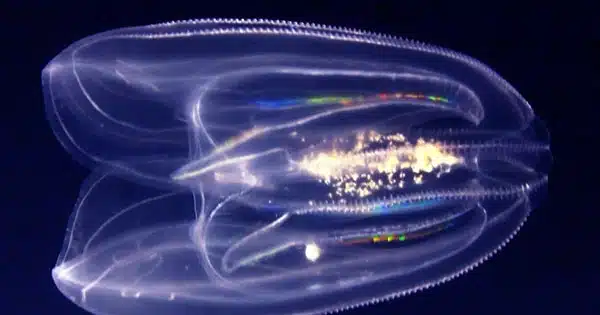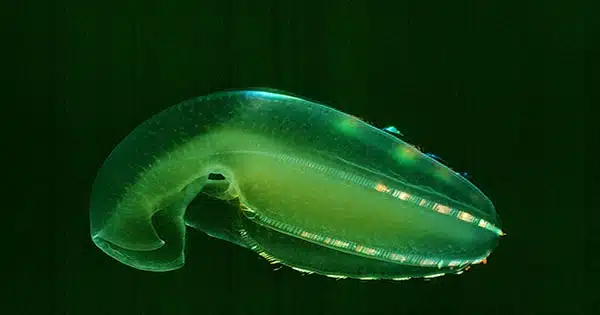Strange creatures that resemble comb jellies known as ctenophores push themselves through the water using microscopic hairs called cilia. They are a mysterious group whose origins date back around 540 million years, but it is unclear exactly when they split off from the rest of the Tree of Life.
Researchers have now found that these animals, which resemble aliens, are far stranger than previously believed: their neurological system is unlike anything that has ever been observed. At least a portion of the ctenophore nervous system is fused, which allows communication without depending on the gaps between nerve cells known as synapses.
“We haven’t actually seen this in any other animal before,” said research co-author Maike Kittelmann, a cell and developmental biologist at Oxford Brookes University in the United Kingdom. “It means that neurons can connect to each other in other ways.”

Evolution of the nervous system
The discovery raises issues about the evolution of all nervous systems and adds fire to a long-running argument about how comb jellies are linked to the rest of the animal kingdom. Many scientists believed that the nervous system in animals originated only once, sometime after sponges separated from the rest of the animal kingdom because sponges lack a nervous system. However, some scientists believe that ctenophores split from other animals early on and evolved their own neurological systems.
Comb jellies lack brains, instead relying on a web-like network of neurons known as the nerve net. The researchers discovered the joined neurons within this neural system. According to Kittlemann, the odd fused layout could indicate that these systems developed independently.
But it’s still an open question.
“We don’t really know for sure,” she said.
The latest study, published in the journal Science(opens in new tab) on April 20, examines ctenophores at an early developmental stage when they are just a few days old. Ctenophores can move around freely and even breed at this stage, but they are not fully mature. (Depending on the species, ctenophores can live for a month to several years.)
Synapses, which are gaps between cells, are used by the vast majority of nerve cells in animals to communicate. To “talk,” neurons send chemicals known as neurotransmitters across these gaps. However, the latest study discovered that within the ctenophore nerve net, the cells are united and their membranes are joined, resulting in a continuous passage from the cell body to the cell body. This formation is known as a syncytium.
“There are some other animals which show fused neurons but not to that extreme, where you have a whole nerve net,” study co-author Pawel Burkhardt(opens in new tab), who studies the evolutionary origin of neurons and synapses in the Norway’s University of Bergen, told Live Science.
Fused neural networks: According to Burkhardt, the discovery presents a slew of new issues, ranging from how this fused network emerges to how it functions. Synapses connect the fused cells to other nerve cells, and synapses are employed by other components of the ctenophore nervous system as well. Burkhardt is unsure why comb jellies need two separate types of communication between their nerve cells.
Leslie Babonis(opens in new tab), an evolutionary scientist at Cornell University who was not involved in the current study, told Live Science that one theory is that the fused neural system offers some advantage for tissue repair and healing. Ctenophores may regenerate an entirely new animal from a little piece of flesh.
“Perhaps this is one of the secrets to their incredible regeneration ability,” Babonis speculated.
The study only looked at one species of ctenophore — Mnemiopsis leidyi — in one embryonic stage, so the researchers want to know if other species have fused brain networks and if this fusion remains throughout the animal’s lifespan.
This could help address issues regarding how the nervous system evolved and whether it appeared once, twice, or three times. If multiple ctenophores have distinct fused neural systems, this could support the theory that ctenophores evolved their nervous systems independently of other animals. However, the researchers believe that all animal nervous systems have a common origin and that ctenophores evolved the fusion later.
Only a few animal lineages have had their neurological systems thoroughly explored, according to Leonid Moroz(opens in new tab), a biologist at the University of Florida’s Whitney Laboratory for Marine Biosciences. Moroz was not engaged in the current work, but he led a 2014 study of ctenophores that discovered that the genetic and chemical underpinnings of the ctenophore brain system differ significantly from that seen in other animals.
If the nervous system is poetry, ctenophores utilize a different alphabet than the rest of the animal kingdom to write it, according to Moroz. He contends that the neural systems of these jellies evolved separately and that other unstudied creatures may have done the same. Unraveling this variety may lead to a better understanding of how neurological illnesses develop.
“We need to understand syntax, and we need to understand grammar,” Moroz explained. “However, we can’t do it with just one or a few species.”















